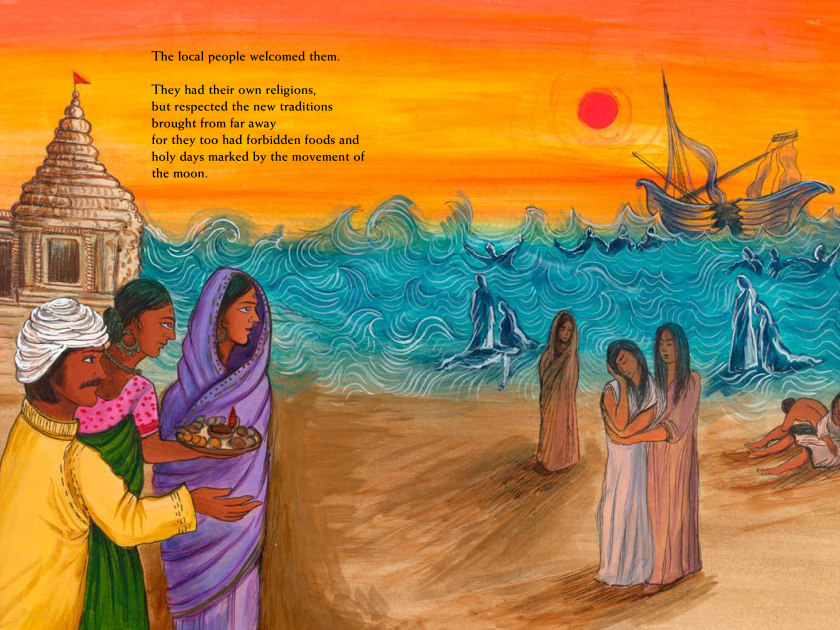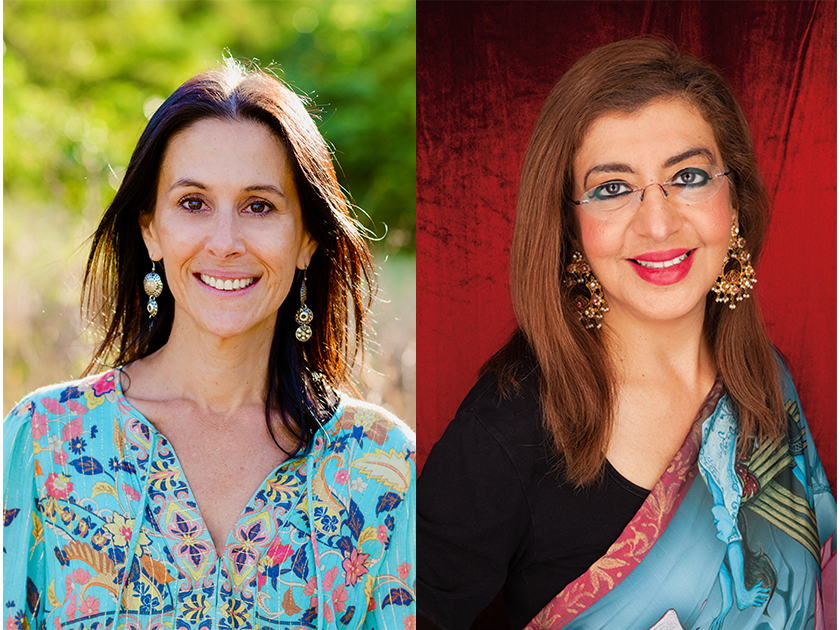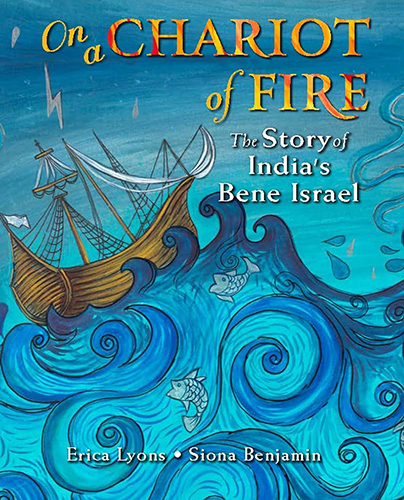
Illustration by Siona Benjamin from On a Chariot of Fire
On a Chariot of Fire, written by Erica Lyons and illustrated by Siona Benjamin, brings the origin story of the Bene Israel — a Jewish community in India — into vibrant color. During the era of the Maccabees and the fight for religious freedom under Greek rule, a brave faction of Jews set out to find a new home. Their ship was caught in a violent storm, and only fourteen survivors made it to shore. The survivors created a new home for themselves, integrating into the customs of the community but also retaining their old traditions and beliefs.
This children’s book explores mythology and its impacts on how we honor our heritage. The story of the origins of the Bene Israel community is one of survival, hope, and adapting to changing circumstances.
Lyons and Benjamin are a powerful team, combining the lived experience of Asian Jews with the desire to educate others who may not be familiar with these histories.
Isadora Kianovsky: How did you two come to work together on this book?
Erica Lyons: Siona and I have known each other since 2011. I chose Siona’s 2010/2011 Fulbright story as the cover story for the Spring 2011 issue of the magazine I founded, Asian Jewish Life. I had “discovered” Siona’s work a couple of years before, and was thrilled to be able to interview her. We developed a friendship and were always looking for new opportunities to work together.
Siona Benjamin: Yes, Erica highlighted my work several times when she ran Asian Jewish Life. It was my pleasure to work with her. Since then, we have met several times when she comes to New York. She’s very scholarly and well-versed on Asian Jewry and my community, the Bene Israel Jews and Indian Jews generally. Like Erica said, we always talked about doing something together. And then COVID hit, right?
EL: Well, first was Growing Up Jewish in India, edited by Ori Z. Soltes (Niyogi Books, Delhi, 2021). We had already worked on that. The focus of the book was on Siona. I wrote an introductory chapter on Jewish life in Asia. Not long after the publication of Growing Up Jewish in India, I stumbled on a post about the first children’s book that Siona illustrated: I Am Hava, by Freda Lewkowicz (Intergalactic Afikoman, 2021).
I had just started paying closer attention to children’s book news because my debut, Alone Together on Dan Street (Apples & Honey Press, 2022), was to be released soon. I remember speaking on the phone with Siona not long after; both of us said excitedly, “I didn’t know you were interested in children’s books too!”
SB: That’s right. We knew we wanted to collaborate again, so a children’s book had to be next.
IK: What was the process like of creating the book as an author and illustrator team?
SB: Since Erica was so knowledgeable about Asian Jews, and particularly about my community of Indian Jews, it was very easy to communicate with her about the different aspects and sensitivities pertaining to my community. She recognizes the diversity of the Jewish people. Because she was immersed in the culture in Asia I felt very inspired to work with her as the author. It was such an easy, flowing dialogue between us.
EL: It was a dream. I’m a fan and a friend of Siona’s. As an author, it feels different when you are so familiar with the illustrator’s work. I’ve interviewed her and critiqued her work. I had a pretty good sense of what the art was going to look like (prior to seeing the final product), so there wasn’t that same sense of surprise, but I was still stunned by the beauty. It was like the feeling of coming home to something familiar.
IK: This book features a community that is not often highlighted in mainstream Jewish stories. What do you hope children take away from the story of the Bene Israel?
SB: I hope people recognize the diversity of the Jewish people; that a community’s customs aren’t weird just because they’re not like the rituals that you perform or you know in your particular community. It’s important to understand and accept that diversity for children and their parents.
EL: I would add that I hope that readers see that even though we have these cultural specificities within Judaism, we’re one people. And this story, while it focuses on the Bene Israel, belongs to all of us in a way, because it’s a part of Jewish diaspora history and the Jewish experience. We were scattered to the four corners of the Earth and that would, of course, include the thousands of years of Jewish presence in India and the Far East.
SB: I’m very happy to have Erica to tell this story with. With others, there’s often a backhanded question asked of me: Where did you guys really come from? Like Erica said, Jews have been in Iran, Iraq, Afghanistan, India, all these countries for two thousand years. Abraham came from the land of Ur. Where is Ur? It’s Baghdad. It’s not in Eastern Europe. You need to remind people of the diversity.
IK: Can you speak more about the incorporation of myth as a cornerstone of all histories and cultures? (For example, in addition to the context of Maccabee uprising and the fight for religious freedom, the origin of the Bene Israel people features Eliyahu Hanavi, a famous figure in the Tanakh).
SB: Myth — the recycling of mythology — is what my work is about. I take from mythology and I renew it to create something that feels new. But mythology is definitely the basis of my inspiration in its ability to be passed from generation to generation.
EL: Because of this generational link, as soon as I came up with the characters of Nani Penkar and her granddaughter Maya, Siona and I both felt strongly that they needed to be there to frame the story. We wanted readers to understand that this story isn’t merely an ancient relic; myth is a living part of culture and identity. Nani Penkar doesn’t simply point to this story in a book. She retells it to her granddaughter and then they participate in Malida, they reenact a part of this story in the very place that it happened. Think of Pesach, where Eliyahu HaNavi incidentally happens to play an important role, too. We tell the story in a way that is immediate. We see ourselves as part of the narrative. The lines between past and present blend, as do the lines between history and myth.
SB: All my work is based on this idea that we can make myths new, but they’re our link to the past. I use midrash as a jumping board to be able to recycle that mythology or story, to bring it forth so that it can be retold for today’s generation in a way that is fresh and new again.
EL: It’s no surprise that we ended up working together! I share the same understanding of the role of myth, though I obviously express it in a different medium, words rather than visual art.
IK: How do you think this book speaks to the idea of home?
SB: I think it speaks to the concept of home in a very diasporic way. And that the Jewish idea of home is not just from one part of the world and not from one kind of culture or tradition, but is varied and blended.
EL: I agree. By telling the story of the Jews in India, it’s a reminder that home is many places for the Jewish people. In the story, they come from ancient Israel. This is their home. They settle in India, which is also their home. And it’s not a contradiction in any way; both places are home. This is what it means to live in the diaspora, wherever it may be.
SB: Indian Jews say Motherland, Fatherland. India is Motherland. Israel is Fatherland. My second Fulbright in 2016 to 2017 was actually titled From Motherland to Fatherland: Transcultural Indian Jews in Israel.
IK: Siona, I know that much of your inspiration for the book comes from stories from your community — are there any specific elements or themes that are particularly meaningful to you? Do you hope to evoke any particular feelings or thoughts through your art here? (I am specifically interested in the symbolism of the color blue in your work.)
SB: I’m inspired by the beautiful rituals of my childhood growing up Jewish in India, and also by the stories told by my family. One of them was this story, passed down from generation to generation. I especially remember the Malida ceremonies during my years growing up. These were performed for the prophet Elijah, as my community believed that he left on his chariot to go up to the heavens from Alibag. Here, we met as a family and as a community. We did the Eliyahu HaNavi prayer, and prepared and ate the Malida (a dish of flattened sweet rice with nuts and crushed cardamom and freshly grated coconut). It was delicious!
In my paintings, I employ the blue-skinned figures as a device to more provocatively raise issues about identity, immigration and the role of art in social change. The blue skin has become a symbol for me of the color of the sky and the ocean, of belonging everywhere and nowhere, and about being a Jewish woman of color.
IK: Erica, can you speak more to your experience working with the Asian Jewish community around the world? How has it influenced your writing?
EL: The Jewish communities of Asia and Asian Jewry have been more than just my work, it’s my life. I’ve lived in Hong Kong for almost twenty-two years and am raising Jewish Chinese children. Actually, Hong Kong was my father’s base for business (Persian rugs) when I was a child, so I suppose all roads led here for me. My childhood home was essentially a collage of his visits to Iran, India, China, Hong Kong, and other Asian countries.
In 2009, I founded Asian Jewish Life, a magazine that aimed to help preserve the unique history of Jews in the region and to change people’s perceptions about where Jews hail from and what they look like. When I closed the magazine, I knew that there were more stories to tell. I amassed a treasure trove of information. Just how Siona spoke about recycling myths, I was determined to find a way to recycle these lesser known Jewish histories. Additionally, children need to see themselves in stories. Collectively, we’re a small part of a tremendous push to create a new cannon of diverse Jewish books reflective of our own Jewish diversity.
IK: What drew you to this particular story? What is it like to tell it for children?
EL: I fell in love with this story the first time I heard it. And when I started seriously writing children’s books in about 2019, I knew that this was a story that I had to tell. One of the first things that I wrote for children was a middle grade short story version of this tale. with a preteen and her mother as two of the seven women that survive the shipwreck.
When Siona and I had that first call and discovered our mutual love for children’s books, we made a list of all the story ideas that we could collaborate on. I said we had to start at the beginning with the origin story. She agreed.
SB: And for me, this is the origin story of my people, my community. It was told to me in my childhood by my grandmother, my mother, my aunts. It’s a story which is so much a part of me, and I have gone to the site of the shipwreck in Alibag with my family. When we pray, it’s usually in our homes. Recently, for my Fulbright, I was there for a big Eliyahu ceremony.
EL: I’ve been to Elijah’s Rock also, but I’ve never been part of a Malida ceremony there. We need to go one time together.
SB: And work on our next book together there, too!

Author photo of Erica Lyons by Paula Weston
Author photo of Siona Benjamin by Sami Studios
Isadora Kianovsky (she/her) is the Membership & Engagement Associate at Jewish Book Council. She graduated from Smith College in 2023 with a B.A. in Jewish Studies and a minor in History. Prior to working at JBC, she focused on Gender and Sexuality Studies through a Jewish lens with internships at the Hadassah-Brandeis Institute and the Jewish Women’s Archive. Isadora has also studied abroad a few times, traveling to Spain, Israel, Poland, and Lithuania to study Jewish history, literature, and a bit of Yiddish language.
